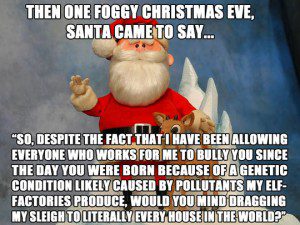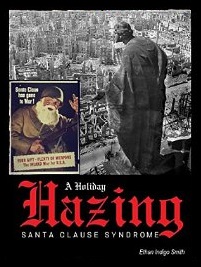My favorite part of the Santa Claus story, without a doubt, was and is, Rudolph the Red-Nosed Reindeer. Rudolph's story is the archetypal representation of the ostracized zero turned hero, and as kid I could relate and empathize with his story especially.
Even after I learned the truth of Santa Claus fiction, I retained an affinity for Rudolph. Little did I know then, nor could I have explicated it as a child, but I love Rudolph because of the archetype he represents. I love the Rudolph story, as do most children judging by how well-known, well-liked and well-marketed Rudolph remains, because of the archetype it portrays.
Rudolph the Red-Nosed Reindeer is the outcast turned underdog, turned hero and transformed leader. As kids we all love Rudolph because he illustrates the outcast hero archetype perfectly. The outcome of the story in isolation is an inspiration to everyone who ever felt rejected or teased for being too young or having too bright a nose, or just being different at all and dreamed of inclusion. As an archetype, it emphatically relates to us all -- except for those who empathize with the ostracizers and cliques, rather than the ostracized.
But over time, the Rudolph archetype becomes a dream slayer. Unlike other childhood hero stories, Rudolph is told to children as fact, not fiction. Then, as children finally realize the deception of Christmas -- the Santa Clause -- many (like me) also realize that such inspiring archetypes as Rudolph exist only in fiction.
The Rudolph ArchetypeMaybe it was just me, but I emotionally empathized with Rudolph more than any part of the who Christmas story. Perhaps this is because I had experienced innocently seeking to play with older kids, who were completely unaccepting of me -- because of my red nose, or red shoes, or red hair, or some similar nonsense. The experience of being rejected like the Rudolph, and then one day coming back with a greatness achieved through the very difference that led to his rejection -- it is practically every outcast child's fantasy, except for the aforementioned clique advocates.
Rudolph relates an inescapable archetype that has been depicted in fairy tales and films alike, from The Ugly Duckling to any number of Hollywood films, where the reject essentially becomes the architect, the hero. The story of Jesus Christ is a story of the reject turned architect too, and other archetypal similarities between Rudolph the Red-Nosed Reindeer and Jesus Christ are worth noting -- like both being the light in the darkness.
So we learn that Santa is not real and had not in fact seen us when we were sleeping, nor knew when we were awake. He had not brought us gifts, appeared at the mall, eaten our cookies, nor been sighted by NORAD. We realize that Rudolph was not real either, teach us, or tricking us to think, that the reject becoming the architect archetype -- that of our 'weaknesses' becoming our strengths -- might only be a fantasy.
Personally, after the initial shock of learning as a child that Santa and Rudolph were not real, and that I was lied to so extensively, I sensed that somehow any sense of 'magic' was questionable now, too. The magic was killed via (mostly subconscious) conclusions associated with that first break with illusion. I learned that if Santa is not real, his magic and therefore magic altogether is not real either, including of course the talking, flying reindeer I related to so fundamentally. Nor must the Ugly Duckling be real. Characters that inspire and reassure us are fictional, not grounded in our reality.

And with the magic gone, the next natural (subconscious) realization is that that only the tangible, material, plastic part of Christmas is real, and by extension, our lives. When the Santa/Rudolph/Magic lie is revealed, the material gifts are the part of the attachment that remains in the child's holiday experience, while little other value is added to the supposedly sacred intent of "holy-days" to fulfill child's developing awareness. Instead, they are given their first "grown-up" lie to keep; one that everyone repeats, because everyone else repeats it.
The Dream SlayerOver the course of our childhood, the Santa Claus story builds up and then snipes down the Rudolph archetype as fiction, suggesting to young minds that the real world will always in fact be controlled by the inner circle of Donner and Blitzen. One might wonder if all stories of the underdog are so rare in the real world, or if it would take magic of some sort to bust out of a conundrum of the status quo.
Even at that time in my life I had seen plenty of people ostracized, myself included, but I had seen little of the reject becoming the architect.
The Rudolph archetype inspires this potential, and the Santa deception hunts it down like so much venison.
It is effectively the first time a child is trusted to bend rules for a perceived more important outcomes, and asks them to mislead the perceptions of others toward a commonly accepted untruth. In a benevolent society, this may not be harmful. In our commercial, disposable, over-regulated society, it is just part of a broader course of collective deception that rewards the unknowing with material possessions, prepping them for a lifetime of aligning to the order of operations of the inner circle -- despite our own unique light.
Merry Total ApathyFrom the Editor
The Santa Claus Syndrome instills more than just materialism and the acceptance of lies. And chances are, if you can recall the names of more than one of Santa's reindeer, you are likely affected by it in some way.
In his book A Holiday Hazing: the Santa Clause Syndrome, Ethan Indigo Smith examines the many psychological influences of one of the most widely celebrated traditions the world has ever known, and exposes common beliefs of 'self' and 'society' in a way that might make you chuckle, and a little bit angry.
A Holiday Hazing: the Santa Clause Syndrome is available on Amazon as an e-book -- just in time for (saving you from) Christmas.
If you enjoyed this article, be sure to check out Ethan's other festive holiday articles The Santa Clause Syndrome (2014) and Merry Total Apathy (2013).
By Ethan Indigo Smith
Contributing Writer for Wake Up World
Previous articles by Ethan Indigo Smith:
- Individuality and Spirituality in the Age of Institutional Rule (w/Andy Whiteley)
- The Matrix of Four Forms of Meditative Breath
- The Great Unsaid: What 1984 Can Teach Us About 2014
- Hate: The Ultimate Social Control Mechanism
- The Failed Politics and Faulty Science of Climate Change (w/Andy Whiteley)
- The Complete Patriot's Guide to Oligarchical Collectivism, an insightful exploration of history, philosophy and contemporary politics.
- Tibetan Fusion a book of simple meditative practices and movements that can help you access and balance your energy.
- The Little Green Book of Revolution an inspirational book based on ideas of peaceful revolution, historical activism and caring for the Earth like Native Americans.
- The Matrix of Four, The Philosophy of the Duality of Polarity on the subject of the development of individual consciousness.
- 108 Steps to Be in The Zone a set of 108 meditative practices and steps toward self discovery and individual betterment, including techniques to develop balance, transmute sexual energy and better the self.
- Terra-ist Letters, a controversial work that humorously contrasts the very serious issues of global nuclear experimentation promotion and global marijuana prohibition.
About Ethan Indigo Smith:
http://wakeup-world.com/wp-content/uploads/2014/05/Ethan-Indigo-Smith1-150x150.jpg Activist, author and Tai Chi teacher Ethan Indigo Smith was born on a farm in Maine and lived in Manhattan for a number of years before migrating west to Mendocino, California. Guided by a keen sense of integrity and humanity, Ethan's work is both deeply connected and extremely insightful, blending philosophy, politics, activism, spirituality, meditation and a unique sense of humour.
Ethan's publications include:
For more information, visit Ethan on Facebook and check out Ethan's author page on Amazon.






